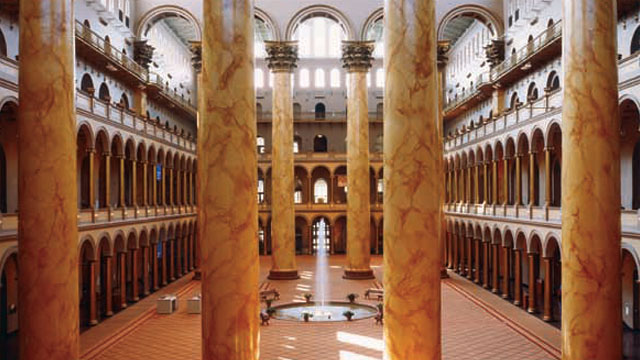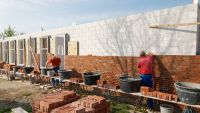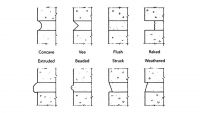September 28, 2011 7:00 AM CDT
Many of us have, as children and adults, spent time exploring different building environments. Playing in a barn in the summer, exploring a vacant building, or visiting a church recalls not only visual memories, but also sensory ones. Recall for a moment, the cool relief of a church interior on a hot day, or the warmth and humidity of the greenhouse on a crisp fall afternoon.
Many of us have, as children and adults, spent time exploring different building environments. Playing in a barn in the summer, exploring a vacant building, or visiting a church recalls not only visual memories, but also sensory ones. Recall for a moment, the cool relief of a church interior on a hot day, or the warmth and humidity of the greenhouse on a crisp fall afternoon.
The construction materials used to build these buildings contribute to their behavior in different climates and add to one’s sense of comfort, whether thermal, acoustical or aesthetic. Buildings that provide the most stable thermal environments are, typically, masonry buildings.
Humans have a 3,000-year history with bricks. It has been in regular use since the ancient empires of Mesopotamia, Rome and China to today’s global societies. Here is why: Many of the ancient structures still visited and studied worldwide today have one thing in common – construction mass. Whether the product used was stone, concrete or bricks, the design and construction of the structure had substantial mass to withstand the erosion of time and remain habitable for centuries.
In addition to surviving the ages, ancient structures and pre-mechanical temperature control buildings used masonry construction as “thermal mass” to control interior living temperatures. Even today, most residential and smaller commercial buildings in Italy, for example, do not have air conditioning. Instead, they combine the use of bricks and other masonry products, with shading, orientation of windows and shutters to keep the structures temperate.
As architects and contractors now look for ways to reduce energy consumption and construct long-lasting, low-maintenance structures, bricks should be considered an essential building material. Thanks to features such as thermal mass, durability and flexibility, bricks can play a major role in achieving society’s current sustainability goals.
Masonry buildings absorb the heat of the sun into the mass of its walls during the day. This helps to stabilize the interior temperature, whether it is hot or cold outside. At night, the stored heat radiates to the interior and exterior of the building, once again helping to maintain a stable thermal environment within. While clay bricks are a feasible option in many locations, hot and humid environments are more complex, requiring greater consideration of all design strategies.
This reduction in the reliance on mechanical heating and cooling systems saves energy throughout the life of the building. Tests conducted by the Oak Ridge National Laboratories of this benefit have shown energy savings as high as 13 percent.
Additionally, bricks are used across the world in every economic region. The abundance of clay – the natural, predominant material in bricks – contributes to its universal manufacturing and application.
Humans have always used, and still use, clay bricks’ thermal mass capabilities as an asset to construct long-lasting livable, attractive structures and can be used to effectively achieve today’s sustainability goals, creating a stronger environment for tomorrow.
Sustainability moves forward with bricks
Bricks have been in regular use since the ancient empires

Photo courtesy of National Building Museum
While the construction industry hunts for the newest sustainable building materials, an ancient product offers substantial sustainability benefits. Bricks, the oldest building material in existence, can improve a building’s energy efficiency, reduce the environmental impact of building maintenance, and easily reach populations around the world.Many of us have, as children and adults, spent time exploring different building environments. Playing in a barn in the summer, exploring a vacant building, or visiting a church recalls not only visual memories, but also sensory ones. Recall for a moment, the cool relief of a church interior on a hot day, or the warmth and humidity of the greenhouse on a crisp fall afternoon.
Many of us have, as children and adults, spent time exploring different building environments. Playing in a barn in the summer, exploring a vacant building, or visiting a church recalls not only visual memories, but also sensory ones. Recall for a moment, the cool relief of a church interior on a hot day, or the warmth and humidity of the greenhouse on a crisp fall afternoon.
The construction materials used to build these buildings contribute to their behavior in different climates and add to one’s sense of comfort, whether thermal, acoustical or aesthetic. Buildings that provide the most stable thermal environments are, typically, masonry buildings.
Humans have a 3,000-year history with bricks. It has been in regular use since the ancient empires of Mesopotamia, Rome and China to today’s global societies. Here is why: Many of the ancient structures still visited and studied worldwide today have one thing in common – construction mass. Whether the product used was stone, concrete or bricks, the design and construction of the structure had substantial mass to withstand the erosion of time and remain habitable for centuries.
In addition to surviving the ages, ancient structures and pre-mechanical temperature control buildings used masonry construction as “thermal mass” to control interior living temperatures. Even today, most residential and smaller commercial buildings in Italy, for example, do not have air conditioning. Instead, they combine the use of bricks and other masonry products, with shading, orientation of windows and shutters to keep the structures temperate.
As architects and contractors now look for ways to reduce energy consumption and construct long-lasting, low-maintenance structures, bricks should be considered an essential building material. Thanks to features such as thermal mass, durability and flexibility, bricks can play a major role in achieving society’s current sustainability goals.
Passive solar energy systems, thermal mass
Passive solar energy systems do not require mechanical equipment to create temperate interior living conditions. Instead, the systems use the exterior surface of a building façade to regulate the temperature indoors.Masonry buildings absorb the heat of the sun into the mass of its walls during the day. This helps to stabilize the interior temperature, whether it is hot or cold outside. At night, the stored heat radiates to the interior and exterior of the building, once again helping to maintain a stable thermal environment within. While clay bricks are a feasible option in many locations, hot and humid environments are more complex, requiring greater consideration of all design strategies.
This reduction in the reliance on mechanical heating and cooling systems saves energy throughout the life of the building. Tests conducted by the Oak Ridge National Laboratories of this benefit have shown energy savings as high as 13 percent.
Durability
Clay bricks can last hundreds or even thousands of years. Other than stone, no other construction product lasts as long as bricks. This construction durability adds value to any property when considering life-cycle costs. Masonry durability reduces both the monetary and environmental costs of maintenance as fewer new resources are needed to repair the structure over time. In addition, the durability of homes and buildings built with bricks add a generational sense of community to towns, cities, village and neighborhoods all over the world.Flexibility, ease of use
Bricks can be used to achieve sustainability goals in every type of building, from single-family homes, hi-rise condominiums and office buildings to public institutions. Within a location, it can be used as an interior wall, floor, ceiling, fireplace profile and as a passive solar energy collector.Additionally, bricks are used across the world in every economic region. The abundance of clay – the natural, predominant material in bricks – contributes to its universal manufacturing and application.
Humans have always used, and still use, clay bricks’ thermal mass capabilities as an asset to construct long-lasting livable, attractive structures and can be used to effectively achieve today’s sustainability goals, creating a stronger environment for tomorrow.
Originally published in Masonry magazine.
About the Authors
Alan Richardson is president of Potomac Valley Brick. Alan operates the BrickStainable Design Competition. Email Alan at alanr@pvbrick.com.
Peter Doo, AIA, LEED AP, is founder and Partner of Doo Consulting LLC. He is a recognized leader in the sustainability industry with experience assisting companies and project teams meet their sustainability goals.


















